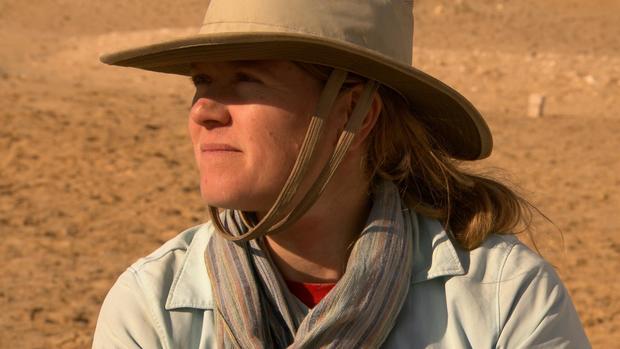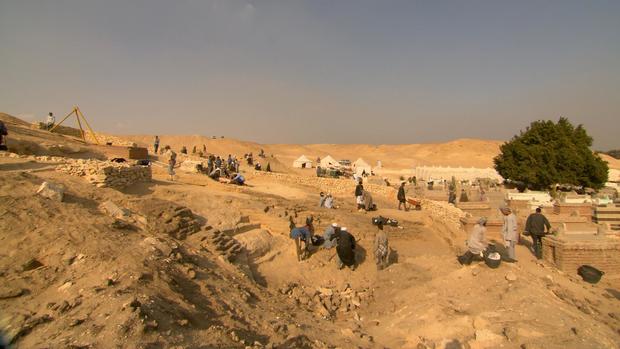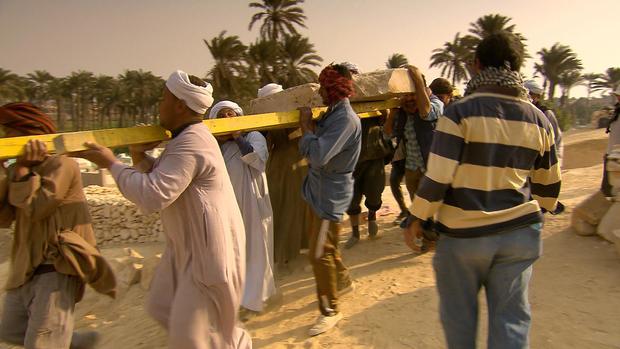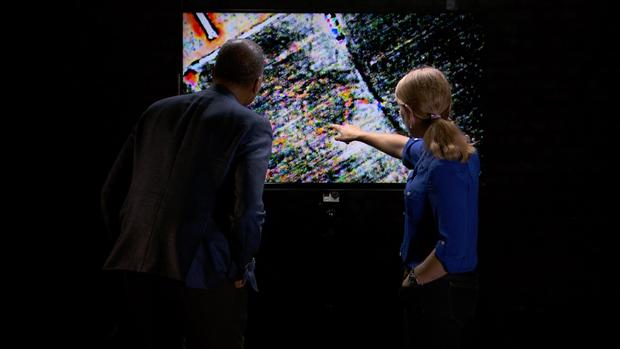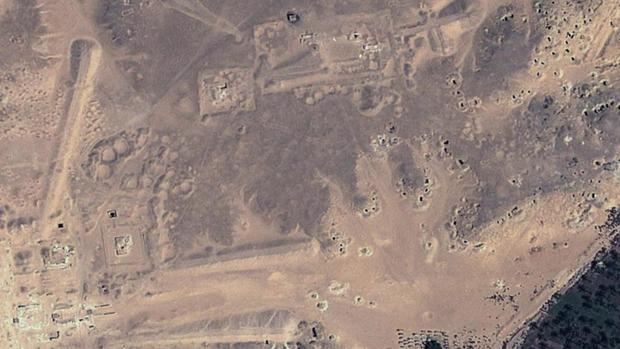"Space archaeology" transforms how ancient sites are discovered
Archaeologists often spend years digging and hoping they'll find the remnants of ancient civilizations. There's a lot of ground yet to be uncovered. Archaeologist Sarah Parcak says less than 10 percent of the Earth's surface has been explored, so she's leading the way to speed up the search. Parcak uses satellite photos to locate ancient sites and she's finding them -- thousands. It's called space archaeology and it's transforming the field. Sarah Parcak is a professor at The University of Alabama at Birmingham. We met her in Egypt doing what she loves most: digging in the dirt.
Our journey took us past the most famous archaeological site on Earth, the Pyramids of Giza rising from the Egyptian desert. Here and elsewhere, modern Egypt is built next to and often on top of ancient Egypt. From Cairo, we traveled 40 miles south and almost 4,000 years back in time to the village of Lisht. Today, the people of Lisht bury their dead in a cemetery at the edge of town, in the same place that ancient Egyptians buried their dead.
Sarah Parcak: Every day, I come to the site. And it's just blows my mind. You know, and this is just one tomb.
At the age of 38, Sarah Parcak is leading the excavation of a tomb that's 3,800 years old.
Bill Whitaker: Were all of the tombs this elaborate?
Sarah Parcak: No, no…so this is special.
Sarah Parcak: This is a big rock cut tomb of a wealthy Middle Kingdom official. It's big.
We watched Parcak's team meticulously dig with trowels and brushes -- after three weeks of this, the tomb buried for millennia was slowly revealed. Most of the discoveries were fragments of pots and inscribed stones. That changed the morning we arrived.
Bill Whitaker: Sarah, what is this? What have you found?
Sarah Parcak: So this is beautiful.
Sarah Parcak: Look at that.
Bill Whitaker: Oh, a hand.
Sarah Parcak: This is amazing.
Bill Whitaker: Look at this. You've got an arm there—
Sarah Parcak: This is a limestone block that was part of this-- probably part of this tomb.
Bill Whitaker: So this is a big find?
Sarah Parcak: It's a very big find. It's the biggest find of our season.
The stone is part of a much larger slab. Look closely and you can make out the lower half of a seated person and the hand of another.
Bill Whitaker: Oh, look at that. That's incredible.
Who's buried here was a mystery until Parcak's team solved it. She took us to an alcove at the back of the tomb where they discovered this stone tablet with a name: Intef. It describes a powerful man...head of the pharaoh's treasury and overseer of his army. Parcak showed us the tablet is damaged and she wondered whether Intef's enemies desecrated his tomb.
Sarah Parcak: Was he corrupt? Was he-- did he step on too many people on his way to the top? Who was this guy? What did he do? But that's what makes archeology interesting...it's like you're reading the ancient version of the National Enquirer in slow time.
Sarah Parcak: I often get asked, you know, especially when we're excavating in tombs, "Don't you feel bad? You're disturbing these people. You know, they wanted to be left alone." Yes, that's true. But on the flipside, the ancient Egyptians, they wanted their names to be remembered.
Bill Whitaker: And to let them live on.
Sarah Parcak: Yeah. And, you know, Intef and his mom and his children, you know, now the world knows them and knows who they are.
Once freed from the Earth, the ancient slab was hoisted using ancient methods. Local villagers do much of the heavy lifting. The man in charge is Omar Farouk.
Bill Whitaker: They call you "Reis"?
Reis Omar: Yes.
Bill Whitaker: What does that mean?
Reis Omar: They call me "Reis," this mean, yani, "the chief."
Bill Whitaker: You're the chief?
Archaeology has been the Farouk family business since the earliest digs in Egypt in the late 19th century. Omar's father, his grandfather and great grandfather oversaw digs like this one. For him, there's pride in both the work and the connection to ancient civilization.
Reis Omar: You know, you say you are Pharaonic people.
Bill Whitaker: You are Pharaonic people—
Reis Omar: Yeah.
Bill Whitaker: You are from the Pharaohs?
Reis Omar: Exactly.
Sarah Parcak: And we think the pyramids were built by aliens. Like, all you have to do is watch these modern Egyptian men move a big stone. And that's it, that's how the pyramids were built, by…
Bill Whitaker: You think this is how they built the pyramids, so—
Sarah Parcak: Yeah, using you know, ramp systems-- large groups of men moving stones. It's-- it's not rocket science, as it were.
From the first pharaohs to the Roman conquest, ancient Egyptian civilization lasted more than 3,000 years. Many of the most impressive artifacts are inside the famed Cairo Museum. But Sarah Parcak, a well-known Egyptologist, is convinced most of ancient Egypt remains undiscovered.
Here at Intef's tomb she's digging for the main burial chamber. Parcak is adept at this old school archaeology … but she's ushering in a new school of the science. She's making discoveries from 400 miles above the Earth while sitting at her desk. She gets infrared photos from DigitalGlobe, a commercial satellite company and looks for shapes, like circles and squares, not usually found in nature, and not easily visible on the ground that indicate human activity.
Bill Whitaker: So what have you found?
Sarah Parcak: A lot. I'm at the point where I can't keep track.
Parcak has found more than 3,000 ancient settlements in Egypt; Roman sites across Europe and North Africa; Viking sites in Iceland.
Sarah Parcak: So, we're gonna look up here.
One of her early important finds was in a farm field near the ancient Roman city of Portus. It's a site in Italy where archaeologists have been digging for a decade, but hadn't been able to find the city's amphitheater until Sarah Parcak looked at the satellite photos.
Sarah Parcak: So what you see in this image are fields. But you can't really see much of anything.
Bill Whitaker: Not much.
Sarah Parcak: So we can go to the next image. OK. So if you see—
Bill Whitaker: A circle.
Sarah Parcak: And what you're looking at is the likely amphitheater of Portus. It's in that field.
Bill Whitaker: How 'bout that?
Bill Whitaker: And from the surface you would see nothing?
Sarah Parcak: Absolutely nothing walking over the top of it.
Bill Whitaker: So your satellite sensors are not peering through the ground?
Sarah Parcak: Uh-unh. No.
Bill Whitaker: You're what? Looking for subtle variations on top of the ground?
Sarah Parcak: Right. So every site in the world is covered by different things whether it's some kind of soil or sand or vegetation. And all of those things are going to be affected in different ways by what's buried beneath the ground depending on whether it's a ditch or a stone wall or a mud brick building. So it's figuring out, it's puzzling out, what's there? What's it made of? Then and only then can you begin processing the image.
At the Portus farm field, that processing shows vegetation – colored orange – that's less healthy than the surrounding crop because of the stones that lie beneath. Parcak teases out the underlying features that can't be seen with the naked eye using sophisticated digital editing. It's like a souped up Photoshop. Just look at this satellite photo of Egypt's ancient city of Tanis -- Parcak fine-tunes the image to turn desert sand into a detailed map. And the structures from a place called Medinet Maadi seem to rise from ground.
And the structures from a place called Medinet Maadi seem to rise from ground.
Sarah Parcak: It almost is at the point where it feels like cheating, where you can see everything from hundreds of miles in space. And it's like that everywhere.
Bill Whitaker: Was this new technique welcomed by the community of archeologists?
Sarah Parcak: When my colleagues and I started finding not just one thing or two things but thousands of things, I think our colleagues were skeptical. "How is it possible that you could be looking in this place that we've been looking for 30 years, and you're seeing thousands of things?" Now, everyone's using it.
Sarah Parcak now is making it possible for everyone to look for ancient sites through her new project: GlobalXplorer. It's a website that invites armchair explorers to flip through satellite images of Peru. Since it started in January, people have examined more than 11 million photos and may have found thousands of unknown sites.
The site in Eqypt where Parcak is digging has been known to archaeologists for decades. But when Parcak looked at satellite photos of the area, she saw what others didn't --- signs of rampant looting.
Bill Whitaker: You can actually see the holes dug by the looters—
Sarah Parcak: Yes, easily. Easily.
Bill Whitaker: From space. Easily?
Sarah Parcak: It's very clear. It's not like ambiguous blob-iness, it-- you can see before and then after. And there are over 800 of them here.
Bill Whitaker: Over 800 of them?
Sarah Parcak: Uh-huh (affirm). Yes.
This is the satellite photo of the area from 2010. Here's the same location in 2013. The dark spots are looting pits. Looting spiked after the Arab Spring in 2011 as tourism plummeted and many of the sites were left unprotected. The area was ravaged and after Parcak shared the photos with the Egyptian government, it asked her to excavate Intef's tomb to preserve and protect what remains.
Sarah Parcak: There's one there. They tried one down there, it didn't work.
Parcak showed us the looting pits seen from space are all around the ancient cemetery... and she believes the fragments of bones and artifacts scattered around Intef's tomb are debris left behind by looters.
Bill Whitaker: Do you think the looters have gotten most of the antiquities from these tombs already?
Sarah Parcak: So it's this question, you know, how long is a piece of string. How much is left after thousands of years? And we all know that looting is part of the human condition. Many of these tombs were robbed in antiquity. You know, I'm never going to be able to tell you what was in a hole after the looters got there.
Bill Whitaker: So these tombs have been looted since ancient times?
Sarah Parcak: Uh-huh. They have been.
Bill Whitaker: It's not just a modern phenomenon?
Sarah Parcak: No, no, no, no. It's been going on for thousands of years.
The objects stolen by modern looting can be bought from ritzy galleries, auction houses and through online sites like eBay. Last November, the U.S. recovered these looted antiquities, including a child's sarcophagus and a mummified hand and returned them to the Egyptian embassy. They're among hundreds of objects that Egypt has repatriated from around the world…some go on display in a special exhibit at the Cairo Museum.
Sarah Parcak: The most important thing for archeological discovery is context. Where did something come from? Then you can begin to understand its function, its importance. That's why for us, as archeologists, looting is such a huge problem. Because when an object is taken out of its original context, we don't know where it comes from. We can't tell you anything about it aside from, "Well, it's a mummy," or, "It's a statue." But that's kind of it. The story doesn't get told.
Archaeology is methodical hard work. The dirt that's removed is carefully sifted for smaller pieces of stone, bone and pottery. Parcak assembled a team of specialists to eke out every last clue from what they find.
Rexine Hummel: I'm always euphoric when I'm here.
Rexine Hummel and Bettina Bader specialize in the jigsaw pieces of pots. Amazingly, you can see the thumbprint from the person who made this one.
Bettina Bader: You are very close to the man or woman who made this.
Bill Whitaker: How about that.
Bettina Bader: How do you feel now?
Bill Whitaker: Just touching something that's thousands of years old is kind of electric.
Bettina Bader: And you see the person's fingerprints and it draws me close to this stuff because they have used it – they have made it, they have used it.
Bill Whitaker: They've touched it and now you're touching it.
Bettina Bader: Exactly.
Sarah Parcak: That's what pulls you back every year. Like, the story is never finished ever.
Bill Whitaker: You find a little bit more and a little bit more and a little bit more.
Sarah Parcak: Every year.
We saw the wonders of ancient Egypt emerging from the desert sand. Sarah Parcak says imagine what more can be found peering down from space.
Produced by David Schneider and Joyce Gesundheit.
